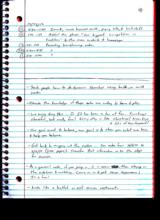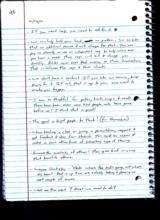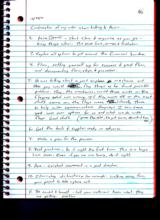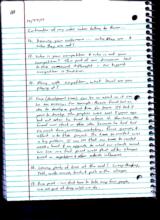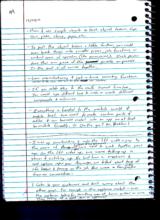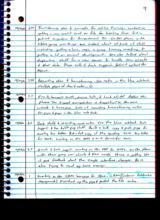|
Basic Assignments
|
Options & Settings
|
Main Time Information
|
||||||||||||||||||||||
|
|
|
|
|
|||||||||
|
|||||||||
|
|
|
Notes:
|
|
-If we give out the code, ask that the companies and the developer give credit where credit is due. This includes God above! Thanks! -I’m thankful for being able to record and write things down. Writing and reading things that have been written help remind us and expands the options. Otherwise we have to keep re-learning and we are never able to stand on other people’s shoulders (their learning, mistakes, knowledge and experiences). -From Joseph Smith – “Teach people correct principles and let them govern themselves.” What a great way to do it! -Empower the people and your users. Then let them take responsibility for their actions. This is called “return and report”. -We need to update and clean-up the help files. We could add graphics, step-by-steps, videos and other links. This could be a huge but needed project. Teach the people! The subjects come second. -Help people get inspired! -Help people see the options and take their own spin off of the vision. This could be training, niche, set-up, consulting, web, design, sales, education, accounting, distribution, etc. -Education for the upcoming generations. -Broad strokes – general sweep of business functions. -Teach people how to do dynamic searches using built-in wild cards. -Elevate the knowledge of those who are willing to learn and play. -We enjoy doing this – it has been a ton of fun. Sometimes stressful, but really fun! Every day is like Christmas! New toys and lots of excitement! -Our goal is not to balance, our goal is to show you what we have and help you balance. -Get back to mapping out the system – see notes from 10/6/10 to 11/6/10 (loose papers). Transfer that information into the steps for success. -As a general note, if you jump in, it is easier than staying on the sidelines and watching. Come on in and get some experience! It is fun! -Kind of like a buffet or self-service restaurant. -If you need help, you need to ask for it. -We can help hold your hand, no problem. We consider that an additional service and will charge for that. You can pay us directly or use an independent rep to help where ever you have a need. Those reps will bill and charge you directly. Adilas never sees that money or those transactions. That is between the reps and their clients. -We don’t have a contract. If you like our service, keep paying for it. If not, that is up to you. We want to make you happy. -I am so thankful for paths, trails, maps and roads. There have been some very kind people who have gone before us! I think that is great! -The goal is to get people to think! (For themselves) -When teaching a class or giving a presentation, request and get feedback and ideas from students. This could be copies of notes or some other kind of voluntary type of sharing. -Harness the creativity of others! Then give back in a way that benefits others. -Wayne Gretzky – “Skate where the pack’s going, not where it’s been.” Head is up and we are actively looking and planning our next couple of moves. -What are the next 3 thing we need to do? -All we need is 200 happy customers! -Think of a time line with multiple levels or lines on it. What business functions are needed for what level? What types of businesses reside or play on what level? -I went to a Christmas party and my brother-in-law had a table runner going down the middle of the table. It was striped with lots of different colors and thicknesses of the lines. I used that table runner multiple times to represent a timeline, difference industries (businesses), and different functions that run or have run over time. It was great! I’d love to use something like that for teaching and demos. -“TIME” is one of the biggest keys to the whole puzzle. It is a moving constant. Because it moves, it could be considered a variable, yet it is measureable and finite. -I’ve got pages (10-12 loose pages) that were part of the brainstorming on elements of time. Make sure and get those documents and record them digitally. -Going back to the party (Christmas party) – we used real objects to talk and teach concepts. We used cups, plates, pans, etc. -You could put pieces of paper in the cups as they moved through time. You could create bridges or relationships. You could run things together; you could create objects and run them through time. We even compared what we had (our objects) to old traditional ways of doing accounting and book keeping. Because the objects had so many pieces, it virtually broke the old model without tons of extra work. It made sense to just map back to the object and have it report what it had. -Show and use simple objects to teach object lessons, cups, cans, plates, string, paper, etc. -To push the object lessons a little further, you could even break things into smaller pieces, job functions, or virtual areas of operation (like permissions). Each person does their own piece of the puzzle or process. In the end it all comes together. -Lean manufacturing and just in time inventory functions. Similar to the above ideas but for data not inventory. -If you relate this to the multi layered timeline, you could use different lines to make or create different components and outcomes. -Everything is headed to the mobile world and mobile level. We need to make certain parts of adilas and our business model into an app or at least be mobile friendly. On the go? No, problem! -I was up snowboarding and rod the life with a guy who I used to work with years ago. On the lift rides up, we were talking up a storm and catching up. He had been a mechanic and used appliance repair guy. Anyway, we talked about tons of life lessons and learning on the job. Here were a few of the notes from our conversations: 1. Cater to your customers and don’t worry about the other guys. For example in the appliance market – was the customer looking for something new at Lowe’s or Sears or were they looking at a used item or appliance? 2. Pace (speed) – start clean and organize as you go – keep things clean. This saves time, energy and frustration. 3. Explore all options to get around the financial burden. 4. Flow, setting yourself up for success and good flow, and documenting flow, steps and processes. 5. He was talking about a good airplane mechanic and the guy would literally flag things as he found possible problems. They, the mechanics, would then write on the flagging what was wrong. If they were off or the next shift came on, the flags were literally there to help with communications. Anyway, I saw some great cross over options for us and what we do with flags. Good stuff. (General flags, dates, flex grid tie-ins, elements of time, etc.) 6. Get the tools and supplies read in advance. 7. Make a plan for the process. 8. Best practices – do it right the first time. This is a huge time saver. Even if you are in a hurry, do it right. 9. Pace – constant movement in a good direction. 10. Eliminating distractions – for example: walking away from your project to take a phone call. 11. Be candid and honest – let your customers know what they are getting. (Expectations) 12. Knowing your customers – who they are and who they are not? 13. Who is your competition and who is not your competition? This part of our discussion led to the comment and thought – our biggest competition is tradition. 14. Along with competition, what level are you playing at? 15. Time (development time) can be an asset or it can be an enemy. For example: His friend had an idea to develop a product line for teens. It took 5 years to develop. The graphics were cool 5 years ago but not when he tried to release it. However, the friend was stuck on the idea because he had, had so much time, energy, marketing, focus groups and effort into the project. The time to market was a big problem. I can see that our time to market needs a boost and an upgrade to what our clients want. We live in a fast paces world that often changes based on expectations and other outside influences. 16. Leaving plenty of time at the end! Wrap things up, test, walk around, touch and push on the changes. 17. Price point – we don’t have to take crud from people, we are good at doing what we do. 18. Map things out! Paper works great! 19. Harness other people’s work. What do they do to be successful? Mix and blend and be your own style. 20. Teach people how to use the product. This includes common features, concepts, underlying technologies, dynamic templates, dynamic searches and build your own stuff. -Some of what we do is considered “smoke and mirrors”. It is not magic; it is showing one thing while doing another thing. This helps us give the appearance of one thing while still satisfying something else. -I’d really like to go in and chop the database into smaller pieces. Then have the application code connect and join things on the fly. My initial thought were make new tables for every 25 corporations. It may be better every 10 or for each corp??? Not sure on that, we’ll see. |

